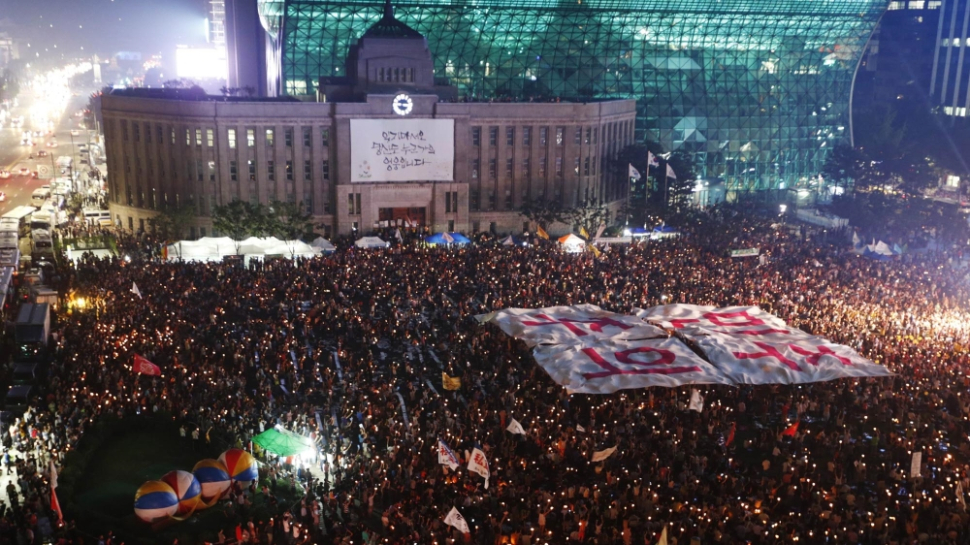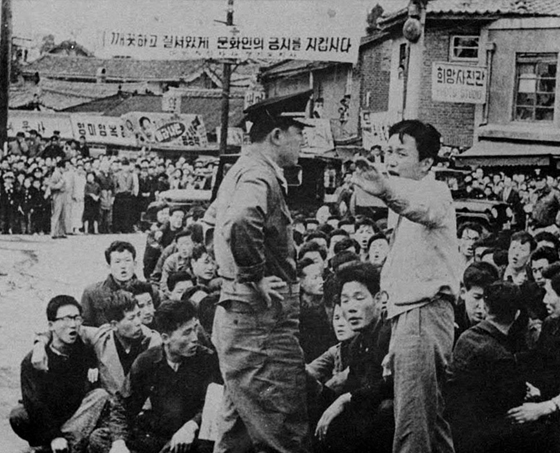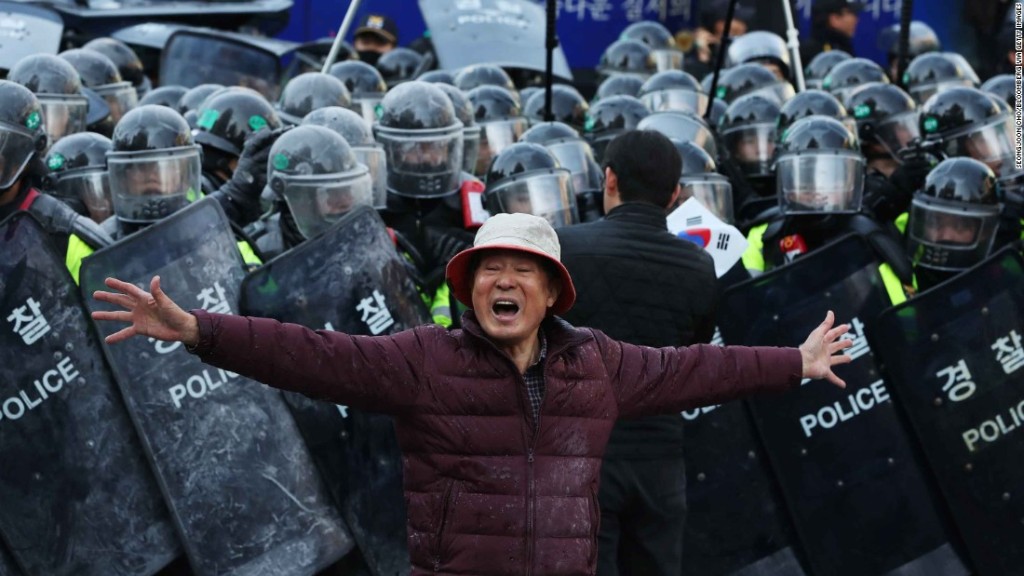There have been many political protests (around 20) in South Korea post-1953, but I’ve decided to only go in depth on three major and revolutionary protests. Mostly student uprisings and ones that enacted severe democratic change that has shaped the way modern South Korea functions. In light of the American Black Lives Matter movement and now the North Korean leaflet revolution, I find it important to reflect and compare on previous demonstrations to see how history played out.
Trigger Warning: There are some heavy topics gone over in this blog post, major injury, death, light gore (mentioning of severe injuries), and police brutality. Please read with caution!

April Revolution 1960
things to know before we move on:
Cronyisitc/Cronyism is the practice of favoring one’s close friends, especially in political appointments.
South Korean Progressive Party was a short-lived moderate socialist political party founded after the Korean War. A major political force from 1956 – 1958, its political position was central-left to left-wing.
Associated Press is an American non-profit news agency. It operates as a cooperative, unincorporated association.
The Blue House is South Korea’s equivalent to America’s White House. Where the sitting President and his/her family lives.
Martial Law is when a military government takes place under Presidential orders – it is the act of suspending ordinary law for a period of time.

Syngman Rhee was the first President of South Korea elected in the 1948 presidential election. Rhee had heavy ties with the United States Army Military and with the creation of the First Republic of Korea. He led South Korea during the Korean War. Rhee’s political standing was heavily anti-communist and pro-American – he commonly used communism as an excuse for political repression.
According to the South Korean public, Rhee was a corrupt dictator who abused his power to maintain his rule in the government. In the name of political unity, this was all tolerated for the duration of the Korean War, but in 1953 (the year the Korean War ended) his cronyistic rule had achieved nothing besides limited economic and social developments – effectively angering the general public.
In the March 1960 presidential elections there was the small Progressive Party (Cho Bong-Am) and the Democratic Party (Cho Pyong-Ok) who were both running against Rhee. Both parties’ candidates died during the pre-election period and this was a tipping point for the South Korean public as many assumed both deaths were the direct results of electoral corruption.
March 15th, 1960, the say day as election results, the Democratic Party in Masan launched a protest against this assumed corruption. At seven-thirty in the evening, roughly one thousand residents gathered in front of the Democratic Party’s Masan headquarters. Here protesters faced off with the police and the city was shut down. The police opened fire on the citizens, who responded by violently fighting back.
April 11th, the body of Kim Ju-Yul, a high school student who went missing during the March 15th rioting, was found in the harbor at Masan. Protestors who did not trust the autopsy authorities conducted forced themselves into the hospital where Kim was kept, and they found that his skull had been split open by a teargas grenade. Which had penetrated from his eyes to the back of his head. Police has shot the teargas at an angle that could more than likely be fatal if shot directly at someone’s face. The news on this incident was heavily censored on South Korean news channels but the story was covered by the associated press thus being delivered to the world. Masan then exploded into spontaneous mass protests that lasted three days and led to even more violent clashes between police and protestors.
April 18th the Masan protests traveled to Seoul, South Korea where university students started non-violent protests at the National Assembly against police violence.
April 19th thousands of university students (with some high school students) marched to the Blue House – their numbers were documented at over 100,000. The protesters demanded for Rhee’s resignation from office. Police opened fire on them, killing 180 and leaving thousands wounded. The Rhee government proclaimed Martial Law on this day in an effort to suppress the demonstrations.
April 26th Syngham Rhee resigned from his position of power and Lee Ki-Poong was blamed for the corruption in the government. (the following day Lee and his entire family was killed in a murder-suicide by the family’s eldest son.)
June Democratic Struggle – June 10-29 1987
things to know before we move on:
Sixth Republic was established in 1987 and remains the current polity of South Korea. With the Sixth Republic the country has gradually stabilized into a liberal democracy.
Yushin Constitution was what governed the Forth Republic of South Korea – Yushin translates to “rejuvenation” or “renewal.” The constitution was a severely authoritarian document marking the sweeping executive and legislative powers granted to the President.
Gwangju Massacre or Gwangju Uprising happened in 1980. Police and military forces opened fire on civilian protesters during a martial law command. 144 civilians, 22 troops, and 4 police officers were killed during these riots. This was the uprising of the Democratization of South Korea.
Roh Tae-Woo was a former South Korean President from 1988 to 1993, the first in the Sixth Republic of Korea.
When former President Park Chung-Hee implemented the Yushin Constitution in 1972, South Korean Presidents were elected indirectly through an electoral college. Even after Park was assassinated and Choi Kyu-Hah replaced him, this electoral college election system stayed in place. The college though, was hand picked by the regime itself, it didn’t represent any semblance of a check on presidential power. This system led to Choi being replaced by Chun Doo-Hwan – who was the nations de facto leader in late 1979 through 1980 under Choi – and later served as the President of South Korea until 1988.
In the 1980s, university student activists struggled against the dictatorship of Chun Doo-Hwan and the enormous aftermath of the Gwangju Massacre. The president of the student council at Seoul National University was one of these students. While detained by authorities in an investigation about previous activist movements, this student was waterboarded in an effort to get him to confess the location of a fellow activist. This torture technique eventually led to his death on January 14th, 1987.
June 9th, 1987, at a demonstration led by Yonsei University students, Lee Han-Yeol was critically injured when a tear gas grenade penetrated his skull. Lee rapidly became a symbol of the protests that followed over the following couple of weeks.
June 10th Major demonstrations happened throughout the country in opposition of Roh Tae-Woo, who was nominated as a candidate for presidency. There were an estimated 240,000 people participating in these demonstrations in twenty-two cities including Seoul.
June 18th 1.5 million people fled into the streets across sixteen cities for the National Rally for Banishment of Tear Gas Grenades. White collar workers joined the protests also, throwing rolls of toilet paper, applauding, and outwardly voicing their support.
June 19th President Chun Doo-Hwan ordered mobilization of the Military in the protesting cities but fueled by the fear of a repeat of the Gwangju Massacre, Chun reversed the order within hours.
June 26th the national movement headquarters for the gain of Democratic constitution held the Great National March of Peace. In thirty-four cities over one million people were in attendance at the demonstration and 3,467 people were arrested.
June 29th Roh Tae-Woo issued the June 29th Declaration. Capitulating to the demands of the protestors by promising to amend the constitution.
2016 – 2017 Candlelight Demonstrations
things to know before we move on:
Chaebols are family owned multi-industry businesses (i.e. Samsung).
College entrance exam is a standardized test that South Korean students take during their senior year in high school to determine acceptance.
Sewol Ferry Sinking on April 16th, 2014 the ferry boat MV Sewol sank in route from Incheon towards Jeju in South Korea. 304 people died including 250 school children on a field trip. 15 crew members and officials have received jail sentences for homicide, fleeing and abandoning ship, and negligence.
Constitutional Court established in 1988, this is an independent and specialized court in South Korea whose primary role is the reviewing of constitutionality under the constitution of the Republic of Korea.

Due to President Park Geun-Hye’s hidden connections to Choi Soon-Sil (a woman with no official position or security clearances) and the disposed secret council Choi was giving Park, a political scandal manifested in October 2016. Choi was revealed to have access to confidential documents and acted as a close governmental confidante for President Park. Park and Choi’s senior staff extorted roughly USD774 million from Korean Chaebols through fake foundations. Choi was also accused for embezzling money and was reported that she rigged the admissions process at Ewha Woman’s University to get her daughter enrolled.
October 25th, 2016 President Park Geun-Hye acknowledged her close relationship with Choi in a press release. Dismissing valuable members of her top office staff and Park’s public opinion rating dropped to just five percent – the lowest ever for a sitting South Korean president. This drop-in rating prompted Park to fire various cabinet members as well as the Prime Minister of South Korea, Hwang Kyo-Ahn. This, in particular, resulted in a controversy as Hwang claimed he was fired through a text message from the President.
October 29th was the first candlelight protest (relatively small in size at 20,000 participants) calling for the resignation of Park Geun-Hye.
November 2016 was the highlight of these protests; every week was a demonstration or altercation, and this was what cemented the beginning of this movement.
November 1st, 2016 a man, using an excavator, crashed into the entrance of the Supreme Prosecutor’s office building in Seoul.
November 5th early Saturday evening, people attended a rally in petition for President Park’s resignation. Organizers claimed more than 100,000 people in attendance.
November 12th Demonstrations led to four police officers being injured, twenty-six protestors taken to the hospital, and an additional twenty-nine were injured and treated at the sight of the protests (Yonhap).
November 19th after taking the College Entrance Exams, a staggering number of South Korean high school students joined the crowds. However, not all South Koreans were against President Park. On this day a short distance from the main protests, a group of conservative protesters gathered outside Seoul Station in defense of the President.
November 28th 1.9 million people fled to the streets in a nationwide anti-President rally.
December 3rd, 2016 2.3 million attended the largest anti-president rally in South Korean history. An estimated 1.6 million people demonstrated from City Hall to Gwanghwamun Square and Gyeongok Palace in Seoul. Around 200,000 more around the city of Busan, and 100,000 in Gwangju.
December 10th hundreds of thousands of people started gathering weekly for protests that were cheering for the impeachment of President Park Geun-Hye.
December 17th the pro-Park supporters held their first major demonstration in Seoul. Organizers claimed roughly 1 million people calling to reinstate the currently impeached president.
December 24th 550,000 people held the Christmas Santa Rally – calling for immediate removal of President Park.
December 31st New Years Eve in South Korea was celebrated with mass protests. Over 1 million people in the streets – bringing the total number of protesters since October to an outstanding 10 million.
January 7th, 2017 Protesters returned to the stress in Seoul with numbers in the hundreds of thousands, demanding the impeached Parks’ immediate removal from office. At this same time these protesters were demanding the salvaging of the remains of a sunken ferry boat that left three hundred dead. Seven in the evening that first Saturday of the new year hundreds of yellow balloons were released and protesters blew out their candles in a symbolic gesture asking for Park to clarify why she was missing for seven hours at the time of the ferry sinking. The people of South Korea were preparing to mark the 1000th day anniversary of the Sewol Ferry Sinking.
January 21st the thirteenth candlelit protest calling for President Park Geun-Hye to resign. Persisting through heavy snow and freezing cold, hundreds of thousands of protestors also demanded the Constitutional Court speed up the finalizing of Parks Impeachment.
February 4th, 2017 the 100th day of the candlelight rallies. 400,000 people gathered at Gwanghwamun Square in Seoul, calling for an extension of the Special Prosecutor’s investigation and for Park to step down immediately.
February 11th hundreds of thousands of South Koreans held conflicting rallies between pro- and anti-impeachment groups. Anti-Park demonstrations held their fifteenth weekly protest and pro-Park supporters waved ROK flags outside Seoul City Hall for their twelfth week. Democratic Party Presidential hopeful, Moon Jae-In, attended the anti-Park rally. He would later go on to become the President of South Korea after Park.
February 25th the fourth anniversary of Park Geun-Hye being sworn into office, saw rival demonstrations in Seoul against her impeachment. As the court prepared to hold its final hearing on Parks Impeachment over corruption, demonstrations continued in full force. Anti-Park organizers claimed 1 million turnout and Pro-Park organizers claimed a turnout of 3 million.
March 2017 The constitutional court removed President Park from power due to the corruption scandal (Park remained silence during). The nation was massively split in a way it’s never seen before, over it’s future. The celebration for Park’s ousting saw tens of thousands of people carrying flags and lit candles in jubilation marching in downtown Seoul. Nearly 20,000 police officers were deployed to monitor these protesters.
Overall, the numbers of people participating in those months long demonstrations totaled an impressive 46 million South Korean citizens. Although it is noted that pro-Park organizations’ claims on numbers of participants has been openly criticized for being “unrealistic” and “exaggerated.”
Sources
Adesnik, A. David, Sunhyuk Kim. “If At First You Don’t Succeed: The Puzzle of South Korea’s Democratic Transition Archived 2011-09-28 at the Wayback Machine”. CDDRL Working Papers. Number 83, July 2008. Retrieved June 9, 2020.
Clyde Haberman and Special to the New York Times. “Seoul Students Torture Death Changes Political Landscape”. Retrieved 11 June 2020
Herald, The Korea (December 3, 2016). “More than 2 million take to streets calling for Park’s resignation”. Retrieved June 19, 2020.
Kim, Quee-Young (1996). “From Protest to Change of Regime: The 4-19 Revolt and the Fall of the Rhee Regime in South Korea”. Social Forces. 74: 1179–1208. doi:10.2307/2580348. ISSN 0037-7732. JSTOR 2580348.
Kim, C. I. Eugene, and Ke-soo Kim (1964). “The April 1960 Korean Student Movement”, The Western Political Quarterly, 17.
“Left wings outrage regarding text firing of Hwang Kyo-ahn”. KyungHyang.
People order Park to step down. (2016, November 27). Retrieved June 23, 2020, from http://m.koreatimes.co.kr/phone/news/view.jsp?req_newsidx=219030
“South Korea scandal: President Park’s friend Choi arrested”. BBC News. November 3, 2016. Retrieved June 19, 2020.
South Korean protester crashes into prosecutors’ office with excavator”. Reuters.com. Retrieved June 20, 2020.
Tennant, Roger (1996). “A History of Korea”, Kegan Paul International London and New York